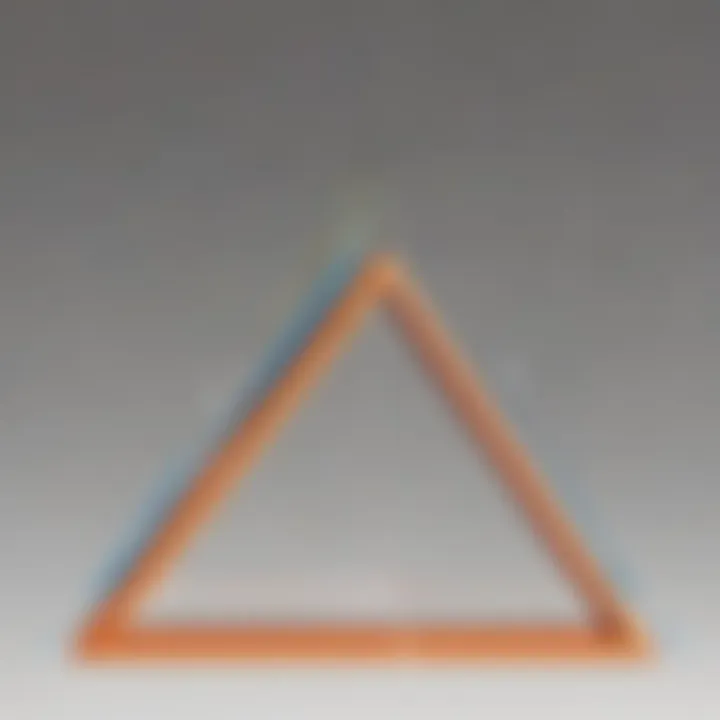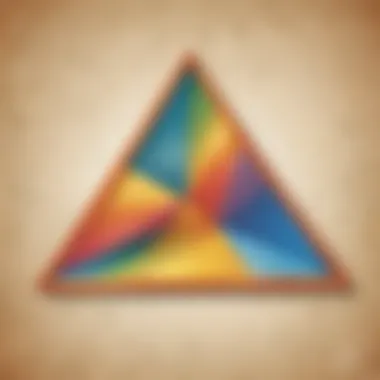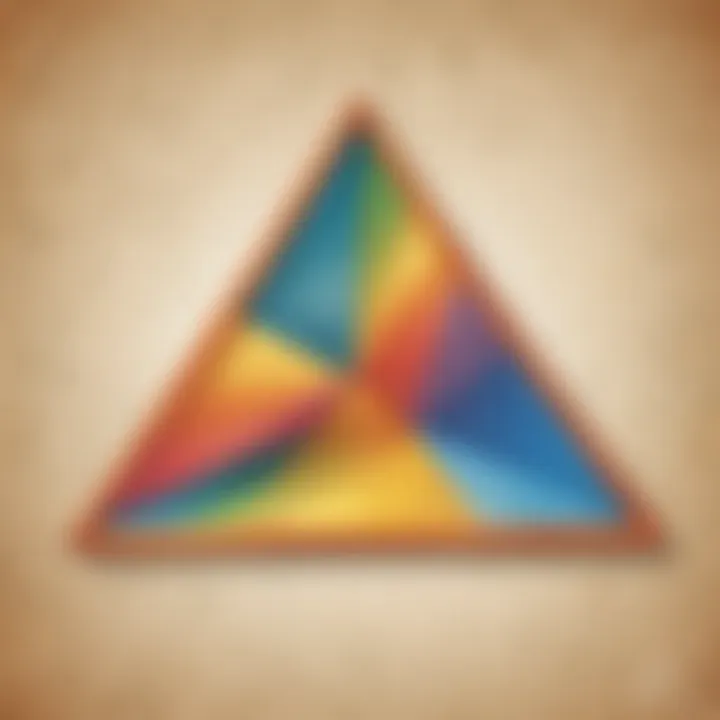Understanding Area and Perimeter in Triangles


Intro
Triangles often catch our eye with their sharp angles and striking shapes. They are not just beautiful; they play a crucial role in understanding geometry, particularly the concepts of area and perimeter.
For elementary school learners, grasping these ideas opens the door to a world filled with endless possibilities for discovery and creativity. This section will unravel the layers of triangle knowledge, making it easier to understand how to measure and utilize these figures. We'll explore different types of triangles, delve into formulas, and share some practical applications that may appear in everyday life. Ultimately, the goal is to foster a sense of confidence in tackling problems involving these shapes.'
Creative Activities
Involving children in hands-on activities helps solidify their understanding of triangles, area, and perimeter. Here are some engaging ideas:
Craft Ideas
- Triangle Collage:
Using colorful paper, kids can cut out various triangles. By gluing them onto a larger sheet of paper, they will create a vibrant artwork while identifying different triangle types. - Perimeter Puzzle:
Create a large triangle outline on a poster board. Children can measure and cut string to match the perimeter and glue the string along the edges. This reinforces the concept of perimeter in a tactile way.
Step-by-Step Guides
- Creating a Triangle Collage:
- Make a Perimeter Puzzle:
- Gather colored paper, scissors, and glue.
- Cut out triangles in various colors and sizes.
- Arrange and glue them on a larger paper.
- Label the types of triangles as they are placed, discussing their properties.
- Cut a triangle shape from a poster board.
- Provide a piece of string longer than the triangle’s sides.
- Have kids measure each side, then cut the string to fit each side precisely.
- Glue the string onto the triangle outline, showing the total perimeter.
Educational Value
These activities not only light a creative spark but also help in understanding geometric concepts. As children engage with their materials and apply their learning, they build vital skills such as measurement and spatial reasoning.
Fun Quizzes
Quizzes are a great way to reinforce what the children learn about triangles. Here are some topics that could potentially be covered:
Quiz Topics
- Types of triangles: Isosceles, Equilateral, and Scalene.
- How to calculate area and perimeter.
- Real-world applications of triangles in construction and art.
Question Types
Children can engage with various question formats like:
- Multiple-choice questions
- Fill in the blanks
- True/False statements
- Matching activities
Knowledge Reinforcement
Quizzes help reinforce knowledge by allowing children to apply what they’ve learned in a low-pressure environment. It’s also a fun way to encourage friendly competition and collaboration among peers.
Fact-Based Articles
To further explore the world of triangles, fact-based articles serve as an excellent resource. Here are some topics that young learners might find interesting:
Topics
- The history of triangles in architecture.
- The role of triangles in nature, like in snowflakes and animal structures.
- Famous mathematicians and their contributions to geometry.
Engaging Content
These articles typically take a conversational tone, breaking down complex ideas into digestible parts. They use vivid imagery and relatable scenarios that resonate with the young audience, sparking curiosity.
Prologue to Triangles
Triangles form an essential bridge between basic shapes and the more complex structures found in geometry. Understanding triangles paves the way for grasping more advanced concepts like area and perimeter. This introduction sets the stage to demystify these calculations, making them accessible to everyone.
Definition and Importance
A triangle is a three-sided polygon, defined formally as a shape with three angles. The sum of these angles always equals 180 degrees. The importance of triangles goes beyond mere definition. They are one of the most fundamental elements of geometry, appearing in various fields—architecture, engineering, art, and even nature. Their stability and strength enable them to serve as structural foundations in buildings and bridges. Understanding triangles serves not just the purpose of solving math problems, but also nurtures everyday skills and critical thinking.
Types of Triangles
Triangles can be categorized into several types, and each type has unique characteristics which play a significant role in calculations of area and perimeter. Below are various types that warrant attention:
Equilateral Triangles
Equilateral triangles boast three equal sides and three equal angles, each measuring 60 degrees. This symmetry makes them particularly appealing in both art and architecture. In terms of area calculation, having equal lengths simplifies finding measurements since knowing one side immediately gives the others. The uniformity of equilateral triangles makes them an ideal starting point for kids learning about shapes and sizes. However, such perfect equality doesn’t lend itself as readily to real-world applications that necessitate a variety of dimensions.
Isocele Triangles


The isosceles triangle is known for having at least two sides that are identical in length. This characteristic causes the angles opposite those sides to be equal as well. This trait makes the isosceles triangle versatile, as it can easily transition from mathematical puzzles to design elements in art. For kids, recognizing these traits can enhance their understanding of symmetry and balance in both math and real life. It can pose challenges too, as misidentifying the equal sides can lead to errors in calculations.
Scalene Triangles
Scalene triangles are the wild ones of the bunch; they carry no equal sides or angles, which can be confusing for young learners. Since all sides measure differently, calculating their area or perimeter requires full attention to every side. The challenge in scalene triangles is also a beauty, showcasing the vast possibilities geometry holds. They encourage kids to engage with diverse numbers, helping them grow more mathematically flexible—a useful skill for life.
Acute Triangles
An acute triangle is characterized by having all angles measuring less than 90 degrees. Despite the simplicity of this definition, acute triangles can be challenging in terms of finding area and perimeter, particularly in visual representations. These triangles are often seen in nature, like when looking up at sails or triangular rooftops. Their shapes can help young learners notice how triangles form various structures around them, making this type a key point in reinforcing practical skills in observations and applications.
Obtuse Triangles
An obtuse triangle contains one angle greater than 90 degrees. This triangle type introduces students to new ideas about angles and their relationships. The presence of an obtuse angle brings a unique challenge when calculating area and perimeter because this angle alters the typical formulas they might initially learn. Embracing obtuse triangles can broaden a child’s understanding of angular relationships and contribute to their overall grasp of geometry.
Right Triangles
Right triangles are undeniably popular thanks to their significance in math—particularly in trigonometry. The right angle, measuring exactly 90 degrees, makes them easy to calculate in terms of area and perimeter. Their unique properties, including the Pythagorean theorem, allow students to probe deeper into geometric principles. Right triangles often serve practical functions too, from constructing buildings to creating artwork, making them an easy way for children to relate math to the real world.
"Triangles are the simplest form of polygons, far and beyond their basic geometric significance in our lives."
In summary, each style of the triangle presents different characteristics and advantages that foster understanding of area and perimeter. This exploration serves as a foundation for mathematics education, equipping young learners with the tools to comprehend and calculate shapes effectively.
Understanding Area and Perimeter
In the world of geometry, the concepts of area and perimeter often stand as cornerstones, especially when it comes to triangles. Understanding these notions not only lays down the groundwork for more advanced mathematical explorations but also helps reinforce everyday problem-solving skills. When students grasp how to calculate the area and perimeter of triangles, they gain a sense of proficiency that extends beyond the classroom. This understanding holds significant value, allowing learners to navigate through various practical situations with confidence.
Area Defined
Concept of Area
At its core, the area represents the amount of space contained within a shape. For triangles specifically, this is particularly interesting. A key characteristic of the concept of area is that it can be calculated using the formula: Area = 1/2 * base * height. This simple yet effective formula makes it an excellent choice in elementary math classes. Its appeal lies in the straightforwardness and the ability for students to visualize it with tangible examples, such as finding the area of a triangular garden.
An important feature of this concept is that area calculations can expand into various applications. For instance, understanding how to determine area can benefit students in real-life tasks—from figuring out how much paint is needed for a triangular mural to calculating the floor space in a triangular room. However, students may occasionally struggle with identifying the correct base and height from diagrams, which presents a small challenge in applying the knowledge effectively.
"Grasping the concept of area can transform abstract math into relatable and engaging problem-solving opportunities."
Area in Real Life
Area in real life adds a unique dimension to how we perceive space and measurement. For younger audiences, the perception of area can be exemplified through familiar instances like determining how much carpet is necessary to cover a triangular section of a room. Highlighting the utility of area in practical life, particularly in situations like gardening plots and home improvement projects, makes it a strong choice for discussion in educational settings.
A unique aspect of area in real life is its ability to inspire creativity. For instance, when children understand the area of a triangular slice of pizza, they may feel compelled to calculate how many slices would fit in their favorite pizza box. This approach fosters both analytical thinking and creative exploration. Yet, sometimes misconceptions arise when students oversimplify the dimensions or ignore real-world constraints like decorations or furniture placement.
Perimeter Explained
Concept of Perimeter
Perimeter, contrastingly, embodies the total distance around a shape—in our case, triangles. This fundamental concept can be grasped with the formula: Perimeter = side1 + side2 + side3. Its simplicity makes it a solid choice for teaching young minds. Understanding perimeter is not just about numbers; it’s about developing a spatial awareness that influences how we perceive boundaries.
An appealing feature of the concept of perimeter is its clarity. For example, once students learn to measure the sides of their favorites toys or paper models, they effortlessly apply this knowledge in classroom or homework assignments. However, challenges occasionally arise when students misread or overlook side lengths, especially in irregular triangles, which can complicate calculations.
Perimeter in Everyday Use
The relevance of perimeter stretches into the daily lives of students. Be it during a game of hopscotch wherein the boundary has a specific shape, or measuring the fence needed for a triangular backyard, the perimeter comes to life. Children can relate concepts of perimeter through sports fields or parks shaped like triangles.
A unique aspect here is how perimeter calculations often tie into larger projects. For example, when initiating a crafting project that involves drawing or cutting triangular shapes, understanding the perimeter allows indviduals to estimate material needs. However, there remains a chance for error when working with insufficient measurements, which can lead to gaps in understanding the total perimeter for larger plans.
These insights into area and perimeter serve to illuminate how geometry connects with practicality in the world around us, encouraging both academic and everyday inquiries.
Calculating Area of Triangles
Understanding how to calculate the area of triangles is crucial in comprehending their overall geometry. This section discusses various methodologies and formulations for determining a triangle’s area, which makes the topic relevant not only in pure mathematics encounters but also in practical, everyday scenarios. Grasping these concepts arms learners with tools that can be applied in numerous fields such as architecture, engineering, and even art.
Basic Formula for Area
Understanding Base and Height
At the core of finding a triangle's area lies the interplay between its base and height. The classic formula is ( \textArea = \frac12 \times \textbase \times \textheight ). Here, the base refers to any side of the triangle, and height is the perpendicular distance from that base to the opposite vertex. This relationship is vital because it simplifies the process of calculating area. It allows students to visualize and conceptualize how triangles expand with the influence of height.
- Key characteristic: The simplicity of the formula makes it accessible for early learners.
- Benefit: It engages children as they can easily identify the base and height on any triangle drawn on paper.
- Unique feature: The relationship between the base and height underlines why triangles are often considered a fundamental shape in geometry. One must keep in mind that if the incorrect base or height is chosen, the calculated area would be off, showcasing the necessity for accuracy in measurements.
Simple Examples
To solidify understanding, let’s explore some straightforward examples. If a triangle has a base of 6 cm and a height of 4 cm, applying the formula yields:
[
\textArea = \frac12 \times 6 \times 4 = 12 \text cm^2\
]
This quick calculation demonstrates how instantly one can grasp the area. Using simple examples becomes a beneficial teaching method as it shows practical applications in for instance, comparing areas of different triangles, like that of a garden space or a piece of art.


- Unique feature: Simple arithmetic reinforces confidence in younger learners.
- Disadvantage: If children rely too much on memorization without understanding the concepts, they might struggle when they encounter more complex problems.
Alternative Methods
With a foundational understanding of the primary formula established, learners often find that there are other viable methods for calculating the area of triangles as well.
Using Heron's Formula
Another method that merits discussion is Heron's Formula. This is particularly useful when triangle sides are known but the height is not easily discernible. The formula states: [ ] where (s) is the semi-perimeter ( \left( s = \fraca + b + c2 \right) ) of the triangle and (a, b, c) are the sides. Heron's Formula highlights a versatile method that allows for area calculation without requiring altitude.
- Key characteristic: It offers a pathway for learners to engage with triangles that may not be positioned ideally for simple height measurement.
- Benefit: Particularly advantageous for various triangle types, especially scalene ones, allowing students to work with what they have.
- Unique feature: The formula encourages young minds to look for relationships among different sides rather than focusing solely on height.
Area via Coordinates
Lastly, calculating area via coordinates introduces a more analytical approach, especially useful for older children or those with a competitive spirit in mathematics. Using the coordinates of the vertices (x1, y1), (x2, y2), and (x3, y3), the formula comes out to:
[
\textArea = \frac12 | x_1(y_2 - y_3) + x_2(y_3 - y_1) + x_3(y_1 - y_2)|
]
This method bolsters skills in spatial reasoning and enhances understanding of graphing.
- Key characteristic: It dives deeper into the connection between algebra and geometry, making triangles even more fascinating.
- Benefit: It is a suitable method for transitional math students, preparing them for high school level geometry and analytic geometry concepts.
- Unique feature: It cultivates critical thinking abilities as students must work with both coordinate systems and triangle properties.
By merging various approaches to area calculation, learners can see triangles in different lights—a foundational aspect for their continued journey in mathematics.
Calculating Perimeter of Triangles
Calculating the perimeter of triangles is not just a practical skill; it’s a fundamental concept that integrates mathematical theory with real-world applications. Understanding how to assess the perimeter allows students to better grasp how geometric figures function not only in classrooms but in daily life. By determining the distance around a triangle, one aids in tasks such as construction, landscaping, and even simple crafts.
Perimeter Formula
Summing the Sides
The primary way to calculate the perimeter of a triangle is through the summation of its sides. This straightforward approach requires simply adding the lengths of all three sides together. The malleability of this method is arguably its most significant charm—it applies universally to every type of triangle, whether equilateral, isosceles, or scalene. The key characteristic here is its simplicity, which makes it suitable for learners at all levels.
One unique feature of summing the sides is that it inherently helps in reinforcing understanding of lengths and measurement. Additionally, it offers students a chance to engage with practical tasks, like measuring real objects or drawing triangles, therefore connecting the abstract to the tangible. However, this process can become cumbersome if students are not accurate in their measurements.
Examples of Perimeter Calculation
Engaging with examples of perimeter calculation is crucial for solidifying the understanding of how to sum the sides. Through examples, learners can visualize or physically see how the perimeter changes based on different side lengths. This tactic serves as a bridge to connect theoretical concepts with observable outcomes.
One standout aspect of these examples is that they lead to deeper conversations about triangles and measurement. For instance, calculating the perimeter of a triangle with sides measuring 3 cm, 4 cm, and 5 cm allows for an instantaneous recognition of the relationship between the sides—highlighting practical math in action. However, students must be careful and check their measurements to avoid errors, which could lead to inaccurate calculations.
Perimeter of Special Triangles
Understanding the perimeter of special types of triangles, like equilateral and right triangles, adds another layer of intrigue. These specific triangles often possess unique properties that make their perimeter calculations even simpler and more intuitive.
Equilateral Triangle Perimeter
When it comes to equilateral triangles, the perimeter can be calculated using the formula:
Perimeter = 3 × side length. This simplicity enhances the learning experience since the sides are identical, allowing students to focus solely on multiplication rather than adding different lengths. The symmetry inherent in equilateral triangles also adds a layer of ease when solving problems, making it a favorite among learners.
However, it’s essential to note that while the formula is easy to apply, students should grasp why the equilateral triangle’s properties facilitate this straightforward computation. Understanding consequences and applications, such as recognizing equilateral triangles in real-world designs, enriches their learning journey.
Right Triangle Perimeter
The perimeter of a right triangle is calculated similarly—by adding the lengths of the two shorter sides and the hypotenuse. The formula is:
Perimeter = side 1 + side 2 + hypotenuse. The right triangle, especially familiar to many due to its applications in fields like architecture, lends itself well to practical examples. The visible right angle provides an easily identifiable feature that keeps students engaged.
What makes the right triangle’s perimeter interesting is the relationship with the Pythagorean theorem, which students often learn simultaneously. While calculating perimeter, students are also simultaneously developing critical problem-solving skills that allow them to connect various mathematical concepts.
In summation, calculating the perimeter of triangles, whether through summing sides or focusing on special triangles, enriches mathematical understanding. This confidence gained in calculating perimeters lays a solid foundation for tackling more complex geometric concepts in the future.
Practical Examples
Practical examples serve a vital role in reinforcing the theoretical concepts surrounding area and perimeter. By embedding real-world scenarios into mathematical learning, students can better grasp these ideas, making them more relatable and easier to understand. Whether it’s measuring the area of a garden plot or figuring out the perimeter of a fence needed around a yard, applying these concepts to life is where the magic happens.
When discussing practical examples, one invaluable element is their ability to nurture problem-solving skills. They encourage students to think critically about how they can apply what they've learned, building connections between mathematics and everyday life. Familiarizing young learners with these practical applications can often spark their curiosity and lead to a deeper appreciation of geometry.
Example: Right Triangle
Measurements and Calculations
When it comes to right triangles, a unique aspect is the straightforward nature of measurements and calculations involved. A right triangle, defined by its right angle, benefits from having one side as the base and another as the height. This feature simplifies the process of calculating area, a trait not shared by all triangle types. The right triangle is popular because many real-life structures, like buildings and ramps, use this shape.
For instance, imagine you're calculating the area of a right triangle with a base of 4 cm and a height of 3 cm. The area formula, which is half the product of base and height, allows you to compute this as follows:
Notably, while right triangles make calculations easier, one must also ensure accurate measurements. Mistakes in length can lead to remarkably different area calculations.
Visual Representation


The significance of visual representation cannot be overstated. It provides clarity and aids comprehension. Seeing a visual example of a right triangle can enhance understanding far beyond mere numbers on a page. Having an image or sketch that shows the base, height, and hypotenuse lays down a strong foundational grasp for learners.
Visuals also allow learners to easily spot patterns and relationships among triangle components. They can be beneficial in illustrating problems, demonstrating how the area or perimeter changes when sides are modified. However, sometimes students may struggle to interpret diagrams correctly, which can lead to miscalculations.
Example: Equilateral Triangle
Understanding Equal Sides
An equilateral triangle is characterized by its three sides being equal in length. Its symmetry is an essential aspect that leads to consistent area calculations. This property makes it an appealing choice for students, as they can use the same measurement for all sides when finding the perimeter or area.
For example, if each side measures 5 cm, calculating the perimeter is a breeze:
Perimeter = Length of one side × 3
Perimeter = 5 cm × 3 = 15 cm
This simplicity in calculating equal sides gives the equilateral triangle a unique charm, making it a common choice in practical problems involving shapes.
Complete Calculations
Diving into complete calculations further enhances the understanding of how area relates to overall triangle properties. For the equilateral triangle, we can use a specific area formula derived from its properties:
This calculation brings together various mathematical concepts, unifying them in one cohesive example. However, it may also pose challenges for younger students who might find square roots and fractions a bit overwhelming.
Common Mistakes in Calculations
When it comes to geometry, specifically triangles, understanding area and perimeter is fundamental. Nevertheless, many young learners stumble on specific points, which can derail their grasp of these concepts. This section aims to pinpoint common mistakes made during calculations, turning potential hiccups into teachable moments.
Recognizing and correcting these errors strengthens one's overall understanding of triangles. Moreover, honing in on mistakes helps learners develop their problem-solving skills, allowing them to tackle more complex geometry as they progress.
Misidentifying Triangle Types
One of the primary errors in working with triangles involves misidentifying their types. Triangles come in various shapes and sizes, including equilateral, isosceles, and scalene. Each type has distinct characteristics and properties that can affect area and perimeter calculations.
For instance, an equilateral triangle has three equal sides, while an isosceles triangle features two equal sides. A scalene triangle? It has no equal sides at all. Failing to identify the correct triangle type can lead to incorrect assumptions about side lengths and angles, ultimately resulting in wrong calculations.
To avoid this, it’s crucial to:
- Observe side lengths: Compare each side to determine which type it is.
- Check angles: Acute, right, and obtuse triangles have specific angle measures that can guide identification.
- Practice with visuals: Drawing or utilizing tools like protractors and rulers can greatly assist in determining a triangle's type.
Understanding how these classifications work in real life can also give a refreshing perspective. For instance, architectural designs often use various triangle forms to enhance both stability and aesthetics.
Errors in Area and Perimeter Calculations
Errors in calculating the area and perimeter of triangles often stem from following incorrect formulas or misunderstanding their components. The area of a triangle is typically calculated using the formula:
A = (base × height) / 2. Meanwhile, the perimeter simply requires the sum of all sides:
P = a + b + c. However, students might mix these up or neglect to consider the proper measurements, leading to frustrating inaccuracies.
Some common pitfalls include:
- Forgetting height measurement: The height must be perpendicular to the base. Misplacing this can cause calculation errors.
- Using incorrect side lengths: If a side is measured incorrectly, it can throw off the perimeter.
- Overlooking special triangle properties: Knowing the formulas for calculating the area differently for certain triangles, like the right triangle, may also help prevent mistakes.
In short, paying close attention to the details is paramount. As students develop their skills in calculating area and perimeter, regular practice and awareness of these common errors are key. Promoting understanding here can lead to greater confidence in tackling triangular problems and geometric concepts as a whole.
"Mistakes are proof that you are trying."
Embracing errors as part of the learning process can be empowering for students.
By addressing these common mistakes, we hope to equip learners with the knowledge and tools they need to successfully navigate the world of triangles and geometry.
End and Applications
The importance of understanding area and perimeter, especially in triangles, cannot be overstated. These concepts are not just confined to the pages of a math textbook; they echo throughout various aspects of our daily lives. From constructing a new garden in your backyard to planning the layout of a room, knowledge of area and perimeter helps us make informed decisions. Especially for young learners, grasping these ideas fosters logical thinking and problem-solving skills that are vital in life.
One critical takeaway from this article is the simplified approach to calculating area and perimeter in triangles. Recognizing that different types of triangles require both unique formulas and methods is essential. Equipped with such knowledge, students can tackle more complex mathematical problems with confidence. Each triangle type presents its distinct characteristics, reinforcing the idea that geometry isn’t just about numbers but also patterns and relationships.
Just like knowing your way around a kitchen makes cooking easier, understanding triangles makes math more approachable!
Recapping Key Concepts
Let’s pull the thread together by revisiting some important concepts discussed.
- Triangles: These three-sided polygons vary in shape and size, each belonging to specific categories, such as equilateral, isosceles, and scalene.
- Area: We found that the triangle’s area can be calculated using the simple formula:( \textArea = \frac12 \times \textbase \times \textheight )
- Perimeter: The perimeter, which is the total length around the triangle, is obtained by summing the lengths of all sides. It’s represented as:( \textPerimeter = a + b + c )
- Common Miscalculations: Simple mix-ups, such as confusing the base and height or overlooking which type of triangle you’re dealing with, can lead to errors.
These points are the building blocks for creating a strong foundation in geometry that students can build upon.
Real-World Applications of Area and Perimeter
Understanding area and perimeter plays a crucial role across various real-world scenarios, including:
- Construction: Builders require accurate area measurements to determine how much land will be needed for a new structure. They also use perimeter calculations to decide the materials needed for fencing or boundaries.
- Gardening: When planning a garden, knowing area helps in designing efficient layouts. You might plant flowers, vegetables, or create pathways based on the space available.
- Art and Design: Artists and designers use these concepts when creating patterns or layouts for their work, ensuring that the dimensions fit well together.
- Sports: Many sports are played on fields that are triangular in shape, such as certain setups used in modern athletics or specialized games. The area of these fields often needs to be accounted for.
As we reflect on the everyday usage of area and perimeter, it is clear that these aren’t just abstract notions. They are integrated into the way we plan, build, create, and even play. By learning this material, students not only excel in their studies but also carry forward a crucial skill to navigate various aspects of life.







